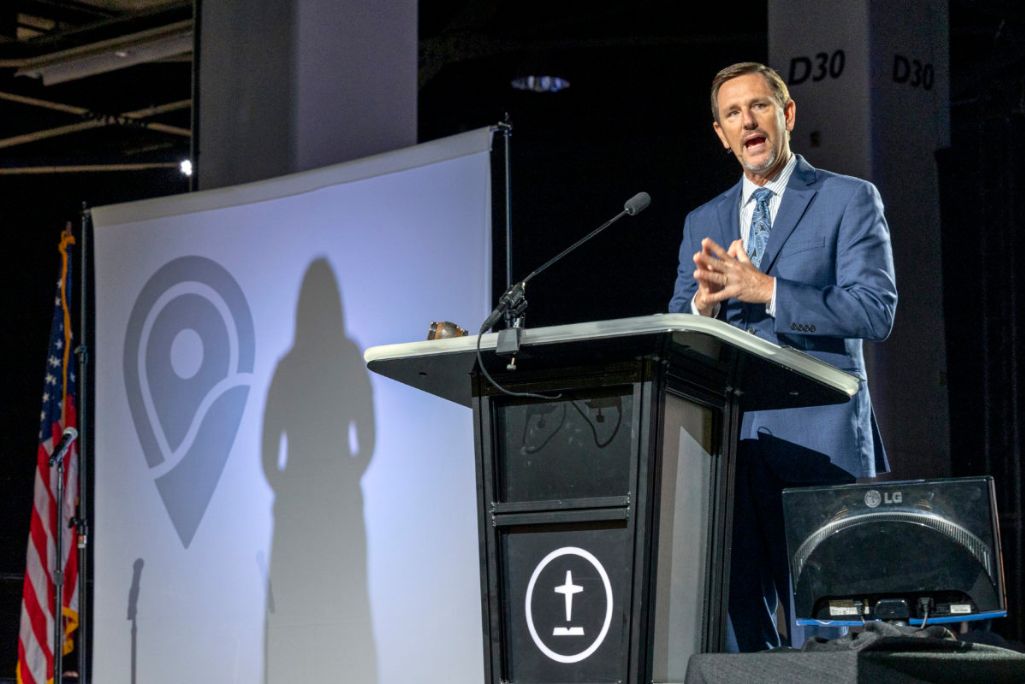
Rose Waligora, who serves with the IMB, greets old and new friends at the Southern Baptist Convention.
The apostle Paul writes to the local church at Philippi of his joyful prayers for them due to his partnership with them. He states in Philippians 1:3-5, “I thank my God every time I remember you. In all my prayers for all of you, I always pray with joy because of your partnership in the gospel from the first day until now.” Paul’s example of communicating gratitude, encouragement, prayers and God’s work is a model that the International Mission Board (IMB) and its missionaries can emulate.
In an empirical study on the relationship between the missionary and the church, researchers Kenneth Nehrbass and David Dunaetz conducted interviews with 17 missionaries and church leaders. Their research aim was to understand why missionaries and churches “form, maintain, and dissolve relationships with each other.” After analyzing the data, the most common theme that emerged from the interviews and appeared over 111 times was the importance of “personal connection.”
The IMB addresses the world’s greatest problem — lostness — with a missionary presence to share God’s good news of salvation among the lost peoples and places around the world.
But missionaries on their own are not enough. They need to be connected with the prayers, partnership, giving and sending of other members from our Southern Baptist churches to support their ministries and strategies. The faithful prayers and sacrificial financial support of churches as they develop partnerships with missionaries and their ministries serve to encourage and inspire both the missionary and the local church.
In the past, new missionaries were encouraged to connect well with three to five Southern Baptist churches, mostly to stay in touch through e-mailed personal and ministry newsletters that share about needs on the mission field and ask for prayer.
Then, when missionaries came home on their stateside assignment (formerly called furlough), they were encouraged to visit churches and deepen their relationships with them. Missionaries also were guided to designate a portion of their stateside time for rest, personal growth and time with relatives.
However, IMB missionaries were only encouraged, not obligated or required, to visit churches stateside, and no one kept them accountable for connecting with churches. The IMB estimated almost 50% of the 47,000 Southern Baptist churches had no known connection to an IMB missionary.
When Paul Chitwood became president of the IMB in 2018, he realized the current system of missionaries building relationships with Southern Baptist churches was not enough. IMB’s new president had formerly served as an IMB trustee and as state executive director for the Kentucky Baptist State Convention.
“We don’t have a resource problem; we have a relationship problem,” Chitwood said at the time.
Furthermore, at the end of 2019, we had 47,000 Southern Baptist Convention (SBC) churches with about 3,600 IMB field missionary personnel. Only 54% of these Southern Baptist churches were financially supporting the Lottie Moon Christmas Offering (LMCO).
Chitwood implemented “2025 Strategic Objectives.” Two of these objectives related to the IMB working closer with Southern Baptist churches. The first was “to mobilize 75% of our Southern Baptist churches to prayerfully and financially support the Lottie Moon Christmas Offering.” The second objective was “to increase LMCO receipts 6% annually.”
To implement these strategic initiatives, a new Church Connections paradigm began in 2020 for IMB active missionaries to connect and engage with all Southern Baptist churches. One IMB career unit per each affinity group is assigned to the IMB’s headquarters in Richmond, Virginia, to serve a three-year term as Affinity Stateside Associates (ASAs). The ASAs’ main task is to help missionaries connect on a quarterly basis with a portfolio of churches. In addition, Field Personnel Orientation (FPO) training staff collaborated with the ASAs to equip new missionaries to connect well with Southern Baptist churches.
The goal of the IMB Church Connections Initiative is for each Southern Baptist church to have a relationship with an active IMB missionary unit (either a single person or a couple) that helps them to grow in their understanding of missions and hear firsthand stories of how God is working around the world. Churches also learn how to deepen their involvement in missions and become closer partners with the IMB.
Most long-term missionaries have an average of around 25 Southern Baptist churches in their portfolios. Mid-term missionaries (Journeymen, ISC, Masters, Macedonia) have an average of 15 Southern Baptist churches in their portfolios for quarterly connection.
The Church Connections Initiative helps the IMB connect with all Southern Baptist churches on a regular basis. The ASAs also work closely with missionary leadership teams to coach them to encourage missionaries to connect well.
After four years, the IMB has seen progress in missionaries engaging with Southern Baptist churches, but there are still some slow adapters who are adjusting to connecting with churches each quarter. One challenge that many missionaries face is that they reach out via email or telephone calls to the churches in their portfolio and do not get a response. This may be because no one is answering a church’s emails or the telephone, or unknown email addresses may be routed into “junk” mailboxes. Pastors and churches may receive the emails but are too busy to reply.
Whatever the reason, a lack of response causes missionaries to wonder if the church contact data is correct, or if perhaps the church has closed, since the missionaries are not receiving a response. Communication and building a relationship take time and trust.
It is important for missionaries to continue to reach out, even if they do not receive a response from churches, with the hope that eventually they will hear a response in the future.
We also greatly encourage our Southern Baptist churches to have someone in the church dedicated to respond if they receive an email, letter or postcard from IMB missionaries. This will help churches to come alongside the IMB in the areas of praying, giving, going and sending.
The apostle Paul wrote to the church in Rome about the importance of the local church and the missionary mutually encouraging one another: “First, I thank my God through Jesus Christ for all of you, because your faith is being reported all over the world. God, whom I serve in my spirit in preaching the gospel of his Son, is my witness how constantly I remember you in my prayers at all times; and I pray that now at last by God’s will, the way may be opened for me to come to you. I long to see you so that I may impart to you some spiritual gift to make you strong — that is, that you and I may be mutually encouraged by each other’s faith” (Romans 1:8-12).
The IMB’s Church Connections Initiative is now four years old. The hope is that this program will allow the missionaries and Southern Baptist churches to develop a thriving relationship with one another that is mutually encouraging and results in an even greater kingdom impact in addressing the greatest problem in the world — lostness.
(EDITOR’S NOTE — This article was first published in the Fall 2024 edition of the Great Commission Baptist Journal of Missions. The journal is available through the IMB. Jeff and Rose Waligora have served with the International Mission Board since 1997. They served among unreached people groups and supervised mission teams across the Asia-Pacific Rim. They currently serve on assignment at the IMB headquarters in Richmond.)


